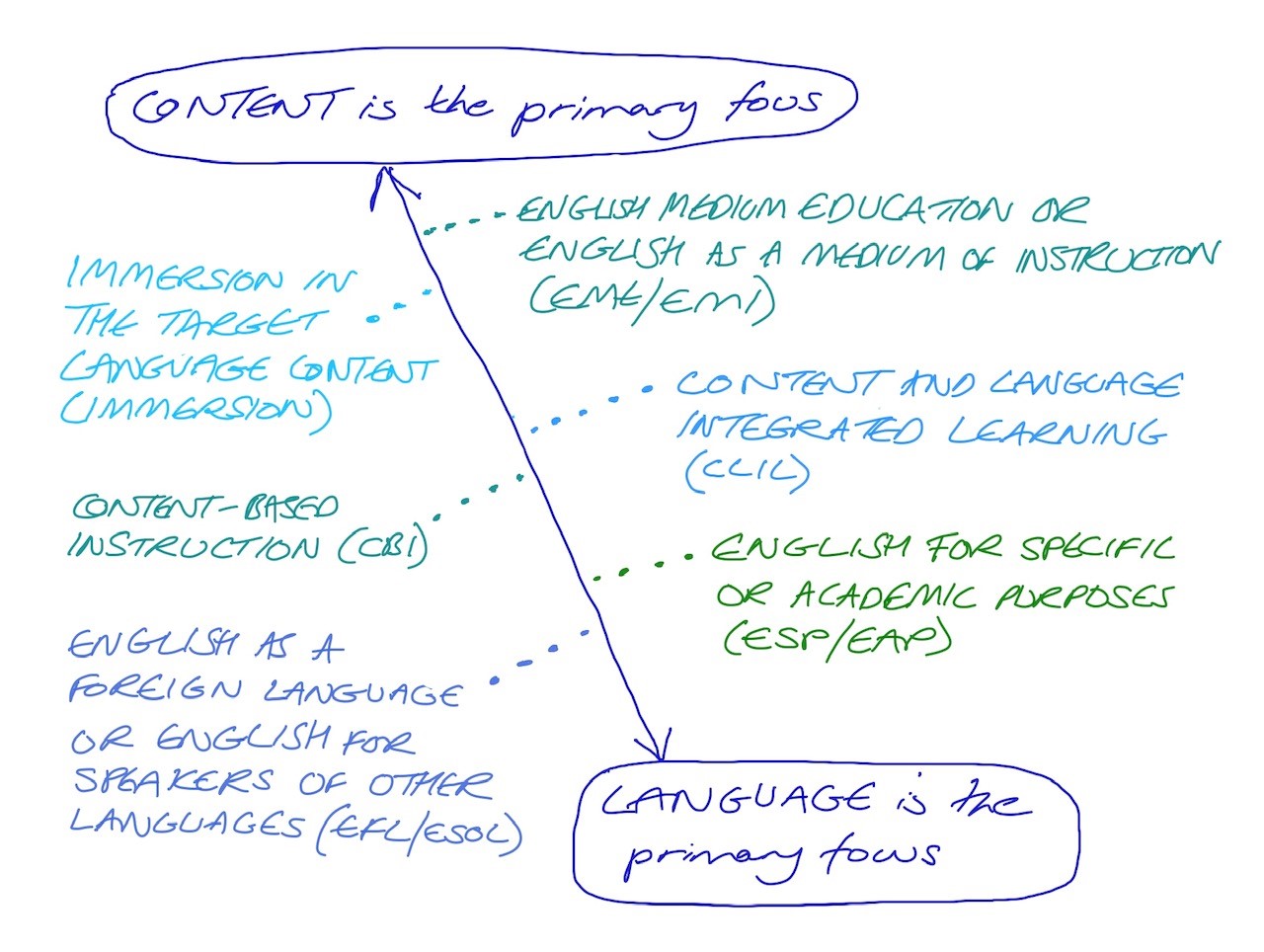English as a Medium of Instruction: all that glitters may not be gold
How much does EMI feature in your teaching? Do you know much about the present and the future of EMI around the world? And why should it matter? Read on to find out more from recent British Council and the European Commission reports and learn about the challenges of CLIL in schools and EMI in universities.
Part of my job as a (part-time) academic and course designer is to keep up with the research literature and any new reports that are published by policymakers. If you have been paying attention, this year alone two important reports have already been published: the British Council’s The Future of English: Global Perspectives report and the European Union’s Key Data on Teaching Languages at School in Europe.
There are hundreds of pages’ worth of information in these two documents, so I will be focusing on a theme that is common to both and is hugely consequential (but uncritically debated) nowadays: English as a Medium of Instruction.
Learning through a foreign language: issues of definition
What is English as a Medium of Instruction (EMI)? Although this term is used extensively in the relevant literature, the British Council actually prefers the term English Medium Education (EME), deeming the word ‘instruction’ too narrow and teacher centred. The authors of the report, Patel et al. (2023:187) argue that EME means ‘the use of the English language to teach and study academic content in places where English is not the primary language of communication of the majority of the population’ – for instance, a degree course may be taught entirely in English in a country from the so-called Expanding Circle, for instance in Japan or Spain, where English is not a first language for most people. They also point out that the focus may be primarily on content, for example teaching engineering concepts, or on language. These two priorities can be thought of as two ends of an EMI (or even EME) continuum (2023:188), which the authors conceptualise based on the existing literature, Met (199:7) and Thompson & McKinley (2018:3). Here is our interpretation of the EME continuum in practice:

EMI and CLIL: my old predictions
At the beginning of last year, I wrote an article titled ‘Taking stock and looking ahead’ in which I analysed seven trends in English language education and made hypotheses about their future development.
One of these trends was the spread of EMI, which I said was on the rise. In terms of CLIL (Content and Language Integrated Learning), which normally refers to EMI in primary and secondary school contexts, I pointed out that although it was regarded as a panacea for low language attainment levels by governments, it presented challenges, especially in low- and mid-income countries. About EMI in Higher Education, I explained how it was driven mostly by the push for student recruitment and internationalisation.
But did these predictions come true?

New evidence: uncritical uptake and challenges
In terms of CLIL, it looks as if it is more widespread than ever, at least in Europe: out of 39 countries surveyed in the Eurydice 2023 report, 35 have CLIL programmes in place. The most common type of CLIL programme consists of teaching certain subjects in the language of schooling (i.e. the country’s main language) and other subjects in a foreign language. In most cases, the foreign language of choice is English.
According to the British Council report, which is based on evidence from all around the world, parents think CLIL is advantageous as a form of learning, and so do governments, which adopt these programmes widely and to fit with their internationalisation agendas.
However, we only need to scratch a little below the surface to see that all that glitters is not gold and the premature adoption of a foreign language may be a hindrance to learning in early years. As the British Council reports, ‘2.4 billion people – nearly 40 per cent of the world’s population – lack access to education in a language they speak or understand (Benson, 2017; UNESCO, 2022), […] while 35 per cent of children globally begin their education in an unfamiliar language’ (2023:190). Further, research suggests that six to eight years of foreign language learning may be required before students can master the necessary skills to learn a subject through a foreign language. This makes the widespread adoption of CLIL programmes not only unnecessary but potentially harmful.
Contrary to what I had predicted, some countries have been taking heed of these issues: after implementing EME programmes at various levels, countries like Indonesia, Malaysia and Turkey have recently reversed course, abolishing EME because it was deemed unfit for purpose. This also relates to a lack of teacher training: by introducing EME on wide scales without the necessary provision for ad hoc teacher training, EME is destined to be riddled with problems.
This also extends to EME in Higher Education contexts. Universities tout the many benefits of degrees in English, such as higher employability and providing access to the latest research literature (most of which is in English). However, little monitoring of these programmes exists, so there is only limited evidence for these benefits. Indeed, the British Council report claims that there is no evidence that EME programmes improve English proficiency, at least not without adequate language support for both teachers and students.

On the other hand, there is empirical evidence pointing to the challenges of EME programmes. These include language-related challenges, such as teachers having to simplify lesson content because they are unable to articulate certain levels of complexity and students struggling to cope with academic English. There are also institutional challenges (e.g. failing to recruit lecturers who can teach in English), cultural challenges and issue related to sourcing materials, which need to be created ad hoc – a time-consuming endeavour for which teachers are often not trained.
This is a point on which prominent EMI researchers, such as Julie Dearden and Ernesto Macaro, agree: EME in Higher Education is destined to grow for reasons of economic growth, prestige and internationalisation. This is likely to happen without the necessary resources (such as teacher training) being allocated for it to be truly successful. In conclusion, they argue, universities are unlikely to pause the growth of such programmes unless research starts showing the actual damage to these institutions if EME programmes are not implemented with the necessary resources and planning.
Are EME programmes common in your country? How are they planned and implemented, and what challenges do they bring in your specific context? Please let us know in the comments or via social media.
References
European Education and Culture Executive Agency, Eurydice (2023). Key Data on Teaching Languages at School in Europe, 2023 Edition. Luxembourg: EU Publications, Publications Office of the European Union. Available from https://data.europa.eu/doi/10.2797/529032 (Last accessed 12 June 2023).
Met, M. (1999). ‘Content-based instruction: Defining terms, making decisions’. NFLC Reports. Washington, DC: The National Foreign Language Centre. Available from https://carla.umn.edu/cobaltt/modules/principles/decisions.pdf (Last accessed 12 June 2023).Patel, M., Solly, M. & Copeland, S. (2023). O’Sullivan, B. & Jin, Y. (Eds.).
The Future of English: Global Perspectives. London: British Council. Available from https://www.britishcouncil.org/future-of-english (Last accessed 12 June 2023).Thompson, G. & McKinley. (2018).
‘Integration of content and language learning’. In Liontas, J. I., DelliCarpinii, M. & Abrar-ul-Hassan, S. (Eds.) TESOL Encyclopaedia of English Language Teaching, 1st Edition. Wiley Online Library: Wiley. Available from https://doi.org/10.1002/9781118784235.eelt0634 (Last accessed 12 June 2023).

Comments
Write a Comment
Comment Submitted